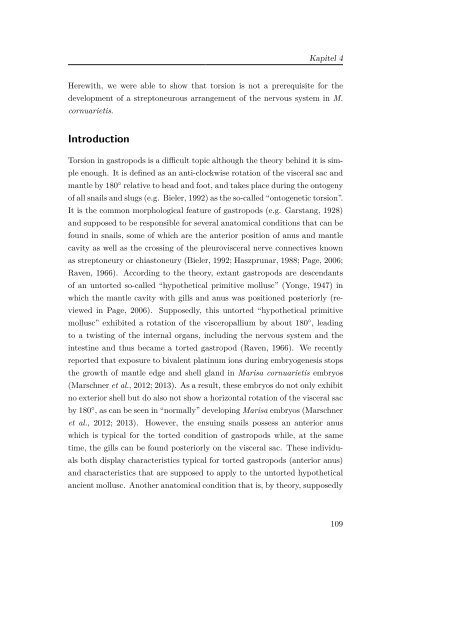Die Embryonalentwicklung der Paradiesschnecke ... - TOBIAS-lib
Die Embryonalentwicklung der Paradiesschnecke ... - TOBIAS-lib
Die Embryonalentwicklung der Paradiesschnecke ... - TOBIAS-lib
Create successful ePaper yourself
Turn your PDF publications into a flip-book with our unique Google optimized e-Paper software.
Kapitel 4<br />
Herewith, we were able to show that torsion is not a prerequisite for the<br />
development of a streptoneurous arrangement of the nervous system in M.<br />
cornuarietis.<br />
Introduction<br />
Torsion in gastropods is a difficult topic although the theory behind it is simple<br />
enough. It is defined as an anti-clockwise rotation of the visceral sac and<br />
mantle by 180 ◦ relative to head and foot, and takes place during the ontogeny<br />
of all snails and slugs (e.g. Bieler, 1992) as the so-called “ontogenetic torsion”.<br />
It is the common morphological feature of gastropods (e.g. Garstang, 1928)<br />
and supposed to be responsible for several anatomical conditions that can be<br />
found in snails, some of which are the anterior position of anus and mantle<br />
cavity as well as the crossing of the pleurovisceral nerve connectives known<br />
as streptoneury or chiastoneury (Bieler, 1992; Haszprunar, 1988; Page, 2006;<br />
Raven, 1966). According to the theory, extant gastropods are descendants<br />
of an untorted so-called “hypothetical primitive mollusc” (Yonge, 1947) in<br />
which the mantle cavity with gills and anus was positioned posteriorly (reviewed<br />
in Page, 2006). Supposedly, this untorted “hypothetical primitive<br />
mollusc” exhibited a rotation of the visceropallium by about 180 ◦ , leading<br />
to a twisting of the internal organs, including the nervous system and the<br />
intestine and thus became a torted gastropod (Raven, 1966). We recently<br />
reported that exposure to bivalent platinum ions during embryogenesis stops<br />
the growth of mantle edge and shell gland in Marisa cornuarietis embryos<br />
(Marschner et al., 2012; 2013). As a result, these embryos do not only exhibit<br />
no exterior shell but do also not show a horizontal rotation of the visceral sac<br />
by 180 ◦ , as can be seen in “normally” developing Marisa embryos (Marschner<br />
et al., 2012; 2013). However, the ensuing snails possess an anterior anus<br />
which is typical for the torted condition of gastropods while, at the same<br />
time, the gills can be found posteriorly on the visceral sac. These individuals<br />
both display characteristics typical for torted gastropods (anterior anus)<br />
and characteristics that are supposed to apply to the untorted hypothetical<br />
ancient mollusc. Another anatomical condition that is, by theory, supposedly<br />
109
















